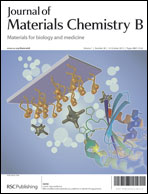Cellular uptake and transfection activity of DNA complexes based on poly(ethylene glycol)-poly(l-glutamine) copolymer with PAMAM G2†
Abstract
Poly(ethylene glycol)-poly(L-glutamine) (PEG-PLGA) copolymer EA-G2 (or EA-G1) was prepared by aminolysis of poly(ethylene glycol)-poly(L-benzyl glutamate) (PEG-PBLG) using PAMAM G2 (or G1). The chemical structure of PEG-PLGA was confirmed by FT-IR, 1H-NMR, DSC and GPC. The performances of the EA-G2 (or EA-G1) were assayed by enzyme degradation, MTT method and agarose gel electrophoresis. The particle size, zeta potential and morphology of EA-G2 (or EA-G1)/pDNA complexes were inspected by DLS and AFM. The cellular uptake mechanism was evaluated by endocytic inhibiting test, cell uptake test and observation of CLSM. The transfection activity was measured by flow cytometry. The EA-G2 (or EA-G1) exhibited good biodegradability, low cytotoxicity and great ability to combine with pDNA. The EA-G2 (or EA-G1) complexes exhibited particle sizes in the range 120–180 nm and zeta potentials in the range 20–40 mV, which were suitable for cell uptake. The cellular uptake of the EA-G2 complexes occurred mainly through clathrin-dependent and caveolin-mediated endocytosis, and at 6 h in 10% FBS and in serum-free media, the percentages of complex uptake reached 89.0% or 72.7%, respectively. EA-G2 complexes could efficiently mediate pEGFP-Cl into the cell nuclei. EA-G2 complexes displayed enhancing transfection efficiency and better serum tolerance. The results suggest that the EA-G2 has potential to be used as a biodegradable, efficient and serum-resistant gene vector.


 Please wait while we load your content...
Please wait while we load your content...